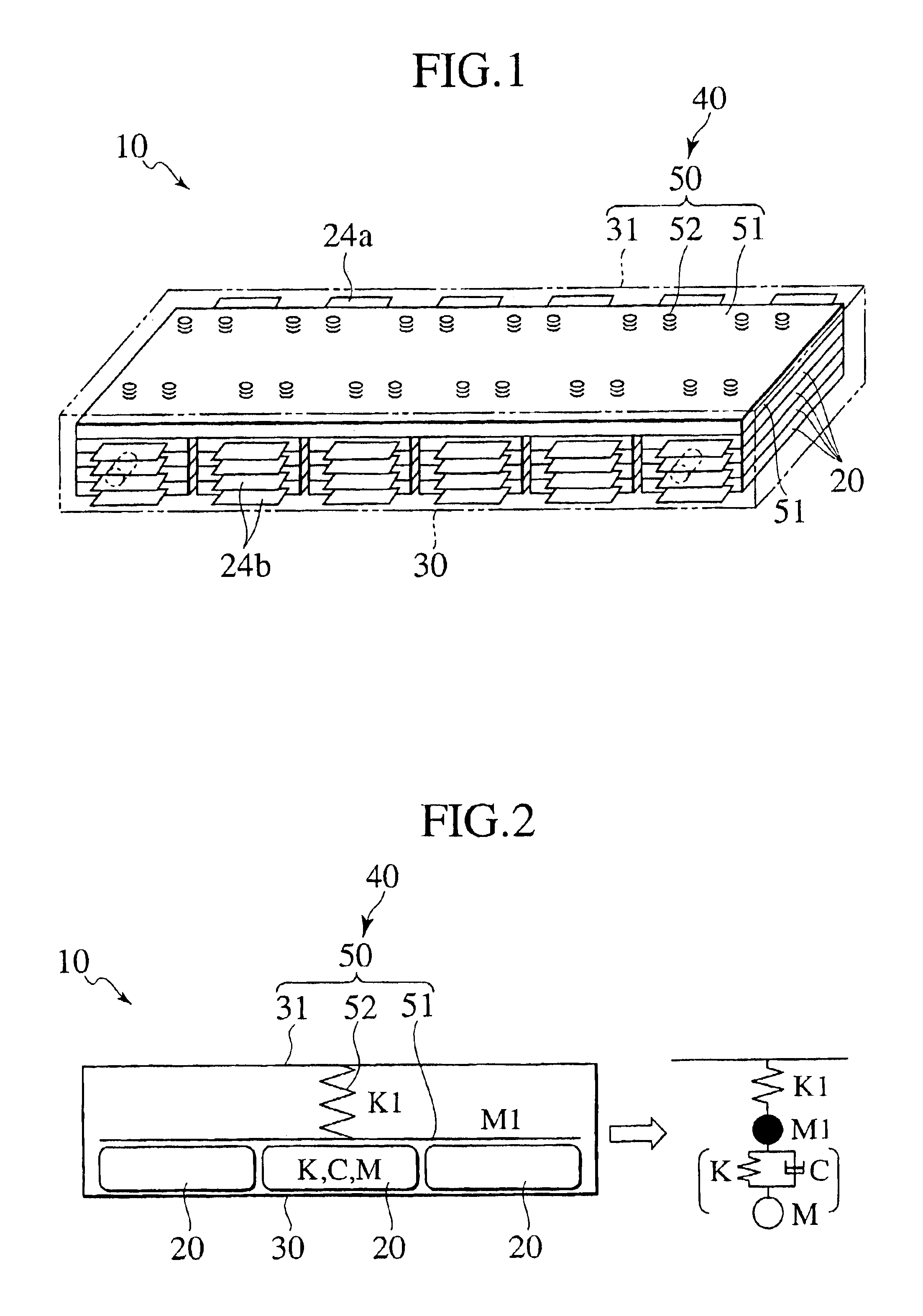Battery pack
a battery pack and battery technology, applied in the field of batteries, can solve the problems of increasing the resistance of the assembled battery, the inability of the structure to exert the vibration isolation effect of preventing vibration, and the vibration inputted to the case is undetected to the assembled battery and the individual unit cells, so as to prevent the vibration of the assembled battery
- Summary
- Abstract
- Description
- Claims
- Application Information
AI Technical Summary
Benefits of technology
Problems solved by technology
Method used
Image
Examples
example 1
[0104]Four pieces of the laminated package unit cells 20 in the form shown in FIGS. 11A and 11B were used. The thickness of each unit cell 20 is 5 mm, and the width of the lab terminals 24a and 24b is 50% of that of the cell body 23. The unit cells 20 were connected to one another in four-parallel, and thus the battery pack 10 shown in FIG. 3A was manufactured. Specifically, four pieces of the unit cells 20 were connected in parallel to be installed as an assembled battery in the metal-made outer case 30. A metal plate as the press plate 51 was installed on the upper portions of the unit cells 20. The metal plate is an aluminum plate having a thickness of 1 mm. Then, the press structure 50 that pressed the metal plate with a surface pressure of 1 kgf / cm2 was formed in such a manner that each of the four coil springs 53 pressed the approximately center portion of the unit cell 20.
[0105]For the battery pack of Example 1, the spectrum of free oscillation of the outer case 30 was measur...
example 2
[0106]The elastic members 52 of the press structure 50 were changed from the coil springs 53 to the disk springs 54, and the battery pack 10 shown in FIG. 3B was manufactured. As shown in Tables 1 and 2, Example 2 is different from Example 1 also in the cell's Young's modulus, the ratio of the pressing force and the cell's Young's modulus, the ratio of the pressed area and the electrode projection area of the unit cell, the ratio of the tab width and the cell width, and the unit cell thickness.
[0107]The primary resonance frequency difference of the battery pack 10 of Example 2 was about. 10 Hz, and the average reduction amount was 2 dB.
example 3
[0108]The elastic members 52 of the press structure 50 were changed from the coil springs 53 to the laminated leaf springs 55, and the battery pack 10 shown in FIG. 3C was manufactured. As shown in Tables 1 and 2, Example 3 is different from Example 1 also in the pressing force, the cell's Young's modulus, the ratio of the pressing force and the cell's Young's modulus, the ratio of the tab width and the cell width, and the unit cell thickness.
[0109]The primary resonance frequency difference of the battery pack 10 of Example 3 was about 100 Hz, and the average reduction amount was 2 dB.
PUM
| Property | Measurement | Unit |
|---|---|---|
| thickness | aaaaa | aaaaa |
| resonance frequency | aaaaa | aaaaa |
| resonance frequency | aaaaa | aaaaa |
Abstract
Description
Claims
Application Information
 Login to View More
Login to View More - R&D
- Intellectual Property
- Life Sciences
- Materials
- Tech Scout
- Unparalleled Data Quality
- Higher Quality Content
- 60% Fewer Hallucinations
Browse by: Latest US Patents, China's latest patents, Technical Efficacy Thesaurus, Application Domain, Technology Topic, Popular Technical Reports.
© 2025 PatSnap. All rights reserved.Legal|Privacy policy|Modern Slavery Act Transparency Statement|Sitemap|About US| Contact US: help@patsnap.com



